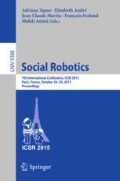Abstract
We propose to use a model of personal space to initiate communication while passing a human thereby acknowledging that humans are not just a special kind of obstacle to be avoided but potential interaction partners. As a simple form of interaction, our system communicates an apology while closely passing a human. To this end, we present a software architecture that integrates a social-spaces knowledge base and a component for incremental speech production. Incrementality ensures that the robot’s utterance can be adapted to fit the developing situation in a natural way. Observer ratings show that personal-space intrusion is perceived as both natural and polite if the robot has the capability to utter and adapt an apology in an incremental way whereas it is perceived as unfriendly if the robot intrudes personal space without saying anything. Moreover, the robot is perceived as less natural if it does not adapt.
Preview
Unable to display preview. Download preview PDF.
References
Baumann, T.: Partial representations improve the prosody of incremental speech synthesis. In: Proceedings of Interspeech (2014)
Baumann, T., Schlangen, D.: Inpro\(\_\)iSS: A component for just-in-time incremental speech synthesis. In: Procs. of ACL System Demonstrations, Jeju, Korea (2012)
Buschmeier, H., Baumann, T., Dorsch, B., Kopp, S., Schlangen, D.: Combining incremental language generation and incremental speech synthesis for adaptive information presentation. In: Procs. of SigDial, Seoul, Korea, pp. 295–303 (2012)
Clark, H.H.: Using Language. Cambridge University Press (1996)
Dylla, F., Kreutzmann, A., Wolter, D.: A qualitative representation of social conventions for application in robotics. In: Qualitative Representations for Robots: 2014 AAAI Spring Symposium Series, pp. 34–41 (2014)
Fischer, K., Soto, B., Pantofaru, C., Takayama, L.: Initiating interactions in order to get help: effects of social framing on people’s responses to robots’ requests for assistance. In: 2014 RO-MAN: The 23rd IEEE Int. Symposium on Robot and Human Interactive Communication, pp. 999–1005 (2014)
Fischer, K., Jensen, L.C., Bodenhagen, L.: To beep or not to beep Is not the whole question. In: Beetz, M., Johnston, B., Williams, M.-A. (eds.) ICSR 2014. LNCS, vol. 8755, pp. 156–165. Springer, Heidelberg (2014)
Hall, E.T.: The Hidden Dimension, Man’s Use of Space in Public and Private. The Bodley Head, London, England (1966)
Kirby, R., Simmons, R., Forlizzi, J.: COMPANION: a constraint-optimizing method for person-acceptable navigation. In: Proceedings of the 18th IEEE International Symposium on Robot and Human Interactive Communication, pp. 607–612 (2009)
Lam, C.P., Chou, C.T., Chiang, K.H., Fu, L.C.: Human-centered robot navigation - towards a harmoniously human-robot coexisting environment. IEEE Transactions on Robotics 27(1), 99–112 (2011)
Levelt, W.J.: Speaking: From Intention to Articulation. MIT Press (1989)
Lindner, F.: A conceptual model of personal space for human-aware robot activity placement. In: Proceedings of the 2015 IEEE/RSJ Int. Conf. on Intelligent Robots and Systems (IROS 2015), Hamburg, Germany (2015) (to appear)
Lindner, F., Eschenbach, C.: Towards a formalization of social spaces for socially aware robots. In: Egenhofer, M., Giudice, N., Moratz, R., Worboys, M. (eds.) COSIT 2011. LNCS, vol. 6899, pp. 283–303. Springer, Heidelberg (2011)
Lindner, F., Eschenbach, C.: Affordance-based activity placement in human-robot shared environments. In: Herrmann, G., Pearson, M.J., Lenz, A., Bremner, P., Spiers, A., Leonards, U. (eds.) ICSR 2013. LNCS, vol. 8239, pp. 94–103. Springer, Heidelberg (2013)
Pacchierotti, E., Christensen, H.I., Jensfeld, P.: Human-robot embodied interaction in hallway settings: a pilot user study. In: 2005 IEEE Int. Workshop on Robots and Human Interactive Communication, pp. 164–171 (2005)
Pandey, A.K., Alami, R.: A framework towards a socially aware mobile robot motion in human-centered dynamic environment. In: Proceedings of the 2010 IEEE/RSJ Int. Conf. on Intelligent Robots and Systems (IROS), pp. 5855–5860 (2010)
Raz, J.: From Normativity to Responsibility. Oxford University Press (2011)
Rios-Martinez, J., Spalanzani, A., Laugier, C.: Understanding human interaction for probabilistic autonomous navigation using risk-RRT approach. In: IEEE/RSJ Int. Conf. on. Intelligent Robots and Systems (IROS), pp. 2014–2019. IEEE (2011)
Sisbot, E.A., Marin-Urias, L.F., Alami, R., Simeon, T.: A human aware mobile robot motion planner. IEEE Transactions on Robotics 23(5), 874–883 (2007)
Skantze, G., Hjalmarsson, A.: Towards incremental speech generation in dialogue systems. In: Proceedings of SIGdial, Tokyo, Japan (2010)
Sommer, R.: Personal Space: Behavioural Basis of Design. Pentice Hall (1969)
Tomari, R., Kobayashi, Y., Kuno, Y.: Empirical framework for autonomous wheelchair systems in human-shared environments. In: Proceedings of the 2012 IEEE Int. Conf. on Mechatronics and Automation, pp. 493–498 (2012)
Yoda, M., Shiota, Y.: The mobile robot which passes a man. In: Procs. of the 6th IEEE Int. Workshop on Robot and Human Communication, pp. 112–117 (1997)
Author information
Authors and Affiliations
Corresponding author
Editor information
Editors and Affiliations
Rights and permissions
Copyright information
© 2015 Springer International Publishing Switzerland
About this paper
Cite this paper
Baumann, T., Lindner, F. (2015). Incremental Speech Production for Polite and Natural Personal-Space Intrusion. In: Tapus, A., André, E., Martin, JC., Ferland, F., Ammi, M. (eds) Social Robotics. ICSR 2015. Lecture Notes in Computer Science(), vol 9388. Springer, Cham. https://doi.org/10.1007/978-3-319-25554-5_8
Download citation
DOI: https://doi.org/10.1007/978-3-319-25554-5_8
Published:
Publisher Name: Springer, Cham
Print ISBN: 978-3-319-25553-8
Online ISBN: 978-3-319-25554-5
eBook Packages: Computer ScienceComputer Science (R0)

